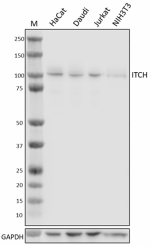- Clone
- W19229A (See other available formats)
- Regulatory Status
- RUO
- Other Names
- ITCHY, Atrophin-1-interacting protein 4, AIP4, HECT-type E3 ubiquitin transferase Itchy homolog, NFE2-Associated Polypeptide 1, NAPP1, AIF4, ADMFD
- Isotype
- Rat IgG2b, κ
- Ave. Rating
- Submit a Review
- Product Citations
- publications

-

Whole cell extracts (15 µg total protein) from the indicated cell lines were resolved on a 4-12% Bis-Tris gel, transferred to a PVDF membrane, and probed with 0.25 µg/mL of purified anti-ITCH (clone W19229A) overnight at 4°C. Proteins were visualized by chemiluminescence detection using HRP goat anti-rat IgG (Cat. No. 405405) at a 1:3000 dilution. Direct-Blot™ HRP anti-GAPDH (Cat. No. 607904) was used as a loading control at a 1:50000 dilution. Western-Ready™ ECL substrate premium kit (Cat. No. 426319) was used as a detection agent. Lane M: Molecular weight marker -

Jurkat cells were fixed and permeabilized with ice-cold methanol and blocked with 5% FBS for 1 hour at room temperature. The cells were then stained with 1.25 µg/mL of purified anti-ITCH (clone W19229A), followed by incubation with 2.5 µg/mL of Alexa Fluor® 594 goat anti-rat IgG (Panels A and B) (Cat. No. 405422) for 1 hour at room temperature. Nuclei were counterstained with DAPI (panel B) (Cat. No. 422801), and the image was captured with a 60X objective. Scale bar: 50 µm
| Cat # | Size | Price | Quantity Check Availability | Save | ||
|---|---|---|---|---|---|---|
| 611451 | 25 µg | 120 CHF | ||||
| 611452 | 100 µg | 295 CHF | ||||
ITCH, Itchy E3 Ubiquitin Protein Ligase or atrophin-1 interacting protein 4 (AIP4), receives ubiquitin from E2 ubiquitin-conjugating enzymes and transfers them to their target proteins for lysosomal degradation. The degradation regulated by ITCH is involved in a broad array of biological functions, including T helper cell inflammatory signaling, T lymphocyte differentiation, immune response, tumor cell death, and skin keratinocyte differentiation. In animal models, ITCH mutant mice develop spontaneous autoimmune disease symptoms including skin scratching, lymphoproliferation, and chronic pulmonary inflammation. ITCH suppresses IL-4 levels by degrading JUNB and maintains the attenuation of differentiation of T helper cells type 2. To maintain peripheral immune tolerance, ITCH monoubiquitinates protein kinase θ and phospholipase C-γ1 through lysosome degradation near immunological synapse for T cell energy. ITCH modulates trafficking of receptor CXCR4 from the cell surface to the endosome through endocytosis. The transcription factor targets of ITCH, such as JUN, JUNB, TP63, NOTCH1, and GLI1, participate in epidermal keratinocyte development and differentiation. In addition to a role in proteolysis, the polyubiquitination of BRAF by ITCH sustains its activity and elevates the MEK/ERK signaling pathway to promote proliferation and invasion in melanoma cells.
Product DetailsProduct Details
- Verified Reactivity
- Human, Mouse
- Antibody Type
- Monoclonal
- Host Species
- Rat
- Immunogen
- Recombinant fragment of human ITCH
- Formulation
- Phosphate-buffered solution, pH 7.2, containing 0.09% sodium azide
- Preparation
- The antibody was purified by affinity chromatography.
- Concentration
- 0.5 mg/mL
- Storage & Handling
- The antibody solution should be stored undiluted between 2°C and 8°C.
- Application
-
WB - Quality tested
ICC - Verified - Recommended Usage
-
Each lot of this antibody is quality control tested by western blotting. For western blotting, the suggested use of this reagent is 0.25 - 1.0 µg/mL. For immunocytochemistry, a concentration range of 1.25 - 5.0 μg/mL is recommended. It is recommended that the reagent be titrated for optimal performance for each application.
- Application Notes
-
For immunocytochemistry (ICC), we suggest fixation with 4% PFA followed by permeabilization with ice-cold methanol or fixation and permeabilization with ice-cold methanol. Fixation with 4% PFA followed by permeabilization with Triton X-100 results in dimmer staining in comparison to the other two methods.
Clone W19229A is not suitable for IHC. - RRID
-
AB_2936758 (BioLegend Cat. No. 611451)
AB_2936758 (BioLegend Cat. No. 611452)
Antigen Details
- Structure
- ITCH is a 903 amino-acid protein with a predicted molecular weight of 102.8 kD
- Distribution
-
Ubiquitous; localized to the membrane, cytoplasm, nucleus, trans-Golgi network, endosome, and lysosome
- Function
- E3 ubiquitin-protein ligase transferring ubiquitin to target protein
- Interaction
- JUN, JUNB, CXCR4, FYN, ERRB4, protein kinase θ, phospholipase C-γ1 and virus proteins
- Cell Type
- B cells, Basophils, Dendritic cells, Eosinophils, Lymphocytes, Neutrophils, NK cells, T cells, Th2, Tregs
- Biology Area
- Adaptive Immunity, Apoptosis/Tumor Suppressors/Cell Death, Cell Biology, Cell Death, Immunology, Innate Immunity, Protein Trafficking and Clearance, Signal Transduction, Stem Cells, Ubiquitin/Protein Degradation
- Molecular Family
- Endosomal Markers, Enzymes and Regulators, Innate Immune Signaling, Ligases, Lysosomal Markers
- Antigen References
-
- Marchese A, et al. 2003. Dev Cell. 5:709-22.
- Chastagner P, et al. 2008. PLoS One. 3:e2735
- Sundvall M, et al. 2008. Proc Natl Acad Sci U S A. 105:4162-7.
- Yin Q, et al. 2019. Nat Commun. 10:1870.
- Gene ID
- 83737 View all products for this Gene ID
- UniProt
- View information about ITCH on UniProt.org
Related FAQs
Other Formats
View All ITCH Reagents Request Custom Conjugation| Description | Clone | Applications |
|---|---|---|
| Purified anti-ITCH | W19229A | WB,ICC |
Compare Data Across All Formats
This data display is provided for general comparisons between formats.
Your actual data may vary due to variations in samples, target cells, instruments and their settings, staining conditions, and other factors.
If you need assistance with selecting the best format contact our expert technical support team.
 Login / Register
Login / Register 









Follow Us